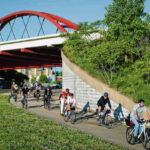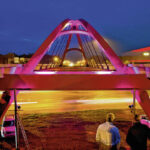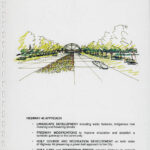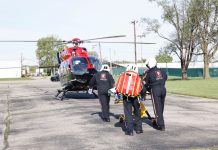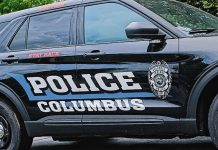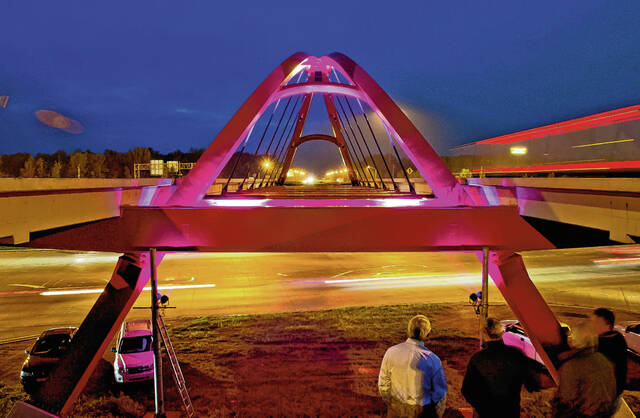
Pictured: A semi streaks past Columbus’ Front Door Bridge during a test lighting Oct. 2, 2012.
The Republic file photo
Design firms and local architecture students are being asked to imagine a possible redesign for a bridge that was created as part of Columbus’ Front Door Project.
Indiana University’s J. Irwin Miller Architecture Program will host an architectural “charrette” to come up with possible concepts for the future of the red, double-arched bridge at the I-65 interchange with State Road 46 on the west side of Columbus. This local landmark could see changes sometime in the future due to highway work by the Indiana Department of Transportation.
INDOT hopes to widen I-65 from four to six lanes from Indianapolis to Louisville, including a stretch across the four-lane signature bridge at Exit 68 in Columbus.
“The governor has set a goal to add travel lanes on I-65 all the way from border to border,” explained City Engineer/Executive Director of Public Works Dave Hayward. “The current construction brings the improvements to the interchange. So it is logical that the interchange will need to be widened soon.”
While there is currently work going on south of the interchange, work on the bridge is not yet funded or scheduled, so any work on the arch bridge would be several years off or longer, Hayward said.
In looking at the future of the arch bridge, Mayor Jim Lienhoop and Hayward reached out to the architecture program, which offered to host the charrette session to brainstorm possible design solutions, said Britt Brewer, of Indiana University’s J. Irwin Miller Architecture Program.
During this event, individuals from four design firms — Browning Day, BSA Life Structures, haptiKB and Louis Joyner Architect LLC — will collaborate with students to form concepts for the structure. The four teams will have a few hours to design and develop their ideas before each giving a presentation at the session’s end.
Lienhoop and Hayward will open the event by framing the issue, and other professionals will inform the teams about aspects of the situation and answer their questions. These advisers include representatives from Gustafson Guthrie Nichol, Storrow Kinsella, the Columbus Indiana Architectural Archives, Strand Associates, Griffy Creek Studio LLC, and the architecture program.
The goal of the event, said Brewer, is to produce something that the city can take to its partners on the project, mainly as a way to foster discussion. None of the concepts will necessarily be implemented.
Hayward described the work being done at the charrette as a “classroom exercise, looking at what if this section of highway is widened and what happens to the existing arch structure at the interchange.”
“This is an INDOT project,” he added. “The city is partnering with INDOT as we have since the current overpass and interchange were constructed in the mid-1990s.”
The double-arched bridge was the centerpiece of the $48 million Front Door Project that began in 1990. The bridge was completed in 1997.
As stated by the Columbus Area Visitors’ Center, the bridge “announces to all who are heading north and south that there is something entirely unique to be experienced in this city with so many architectural assets that it lives up to the claim that it is ‘unexpected’ and ‘unforgettable.’ ”
“One of the questions to ask is ‘How does a small Midwestern community announce itself on the interstate?’” said Brewer. “If you go anywhere on the interstate and you stop at a McDonald’s, you could be at any exit on any interstate virtually anywhere in the country. So how do you know where you are? That’s one of the issues that the bridge that crosses at (State Road) 46 sort of deals with. There’s not another bridge like it on an interstate anywhere in the country.”
Republic file photo Bicyclists pedal to downtown Columbus on the People Trail near Front Door Bridge during the annual Bike To Work Day, Friday, June 6, 2014.
Pictured: A semi streaks past Columbus’ Front Door Bridge during a test lighting Oct. 2, 2012.
The Republic file photo
Photo provided A concept description of the arch bridge from the Columbus Indiana Architectural Archives.

